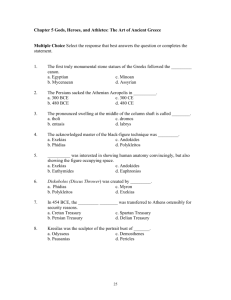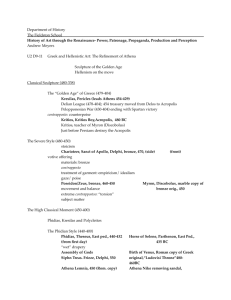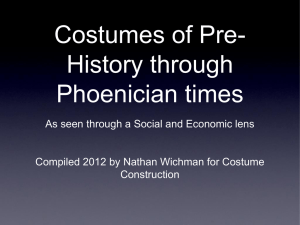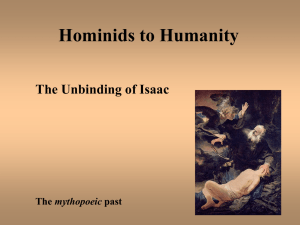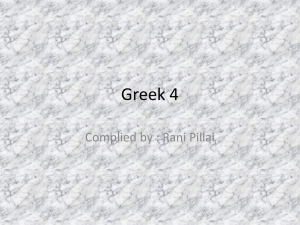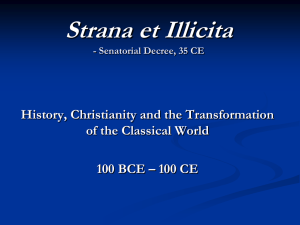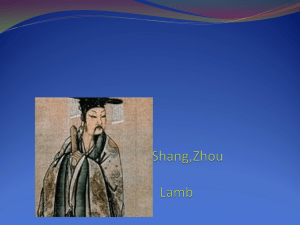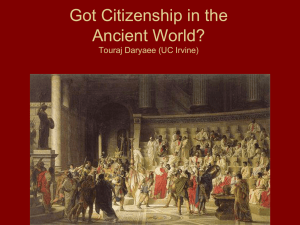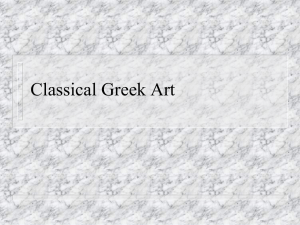The Classical Period 480 – 400 BCE
advertisement
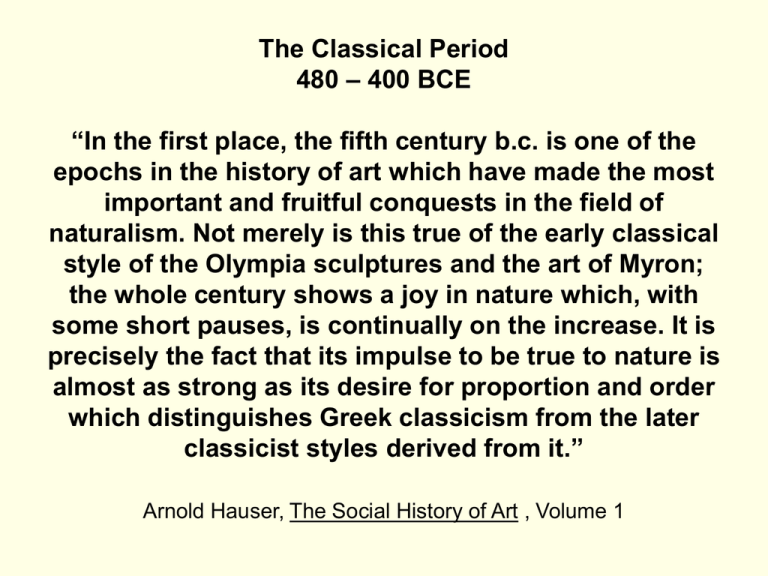
The Classical Period 480 – 400 BCE “In the first place, the fifth century b.c. is one of the epochs in the history of art which have made the most important and fruitful conquests in the field of naturalism. Not merely is this true of the early classical style of the Olympia sculptures and the art of Myron; the whole century shows a joy in nature which, with some short pauses, is continually on the increase. It is precisely the fact that its impulse to be true to nature is almost as strong as its desire for proportion and order which distinguishes Greek classicism from the later classicist styles derived from it.” Arnold Hauser, The Social History of Art , Volume 1 The Classical Period is one of the most important periods for its influence on later styles and periods of art. As we will see this period influenced the great Italian Renaissance sculptors Donatello and Michelangelo and the late 19th century artist Rodin. Polykleitos was trained in the Severe Style and extended the concepts of that period creating even more fluidity in the movement. In the Classical Period the muscular development connecting torso to legs becomes more pronounced. It has been suggested that the athletes of the period actually developed this area rather than this being an invention of the sculptors. The Doryphoros or Spear Bearer demonstrates the new ideals in regards to the beautiful in Greek art. Proportion and contrapposto become more subtle and, to create a more lyrical figure Polykleitos adds an interesting system of cross balances in the arms and legs. This system softens the absolute symmetry of the human body creating a contrast in the bodies contour on the left and right. Praxiteles is one of the most important sculptors of the 4th century BCE and his work demonstrates the changes that take place in Greek art of this period. In earlier periods the artists seem to have held to a common aesthetic but in the Classical Period the artists seem to develop more individual forms. Praxiteles continues the use of weight shift, contrapposto but adds to it the “S” curve. These three devices give the figure more grace and beauty Praxiteles – Hermes and Dionysos Ca. 340 BCE The female nude was extremely rare until the 4th century BCE. It has been said that Praxiteles was the first to sculpt the female nude. Kenneth Clarke wrote in his scholarly work, The Nude, “It is remarkable that in the female nude there is hardly a single formal idea of lasting value that was not originally discovered in the 4th century.” Knidos was the sacred island of Aphrodite (Aphrodite becomes Venus in Rome). Praxiteles created the cult idol for her temple on the island. As one entered the temple they would view the Goddess from behind as she steps into a ritual bath. Notice at the feet of Aphrodite there is a dolphin with Eros on its back. These are symbols of the goddess and we will see them again on the Roman Augustus of Primaporta. Venus de Medici (after Praxiteles) Pliny, the Roman writer, said of Praxiteles’ Aphrodite, it was “ superior to all works of art, not only of Praxiteles, but indeed in the whole world. There is a tale that two male pilgrims went to Knidos to pay homage to the goddess of love. As they entered the temple they saw the statue of the goddess as we see her in the Venus de Medici. They were so taken with her beauty that they bribed the priest to allow them to come around so they might see her in her full glory. Another story about the beauty of Aphrodite concerns Phidias. Phidias had done a sculpture of the goddess and when it was seen a rumor spread through Athens that the model was as beautiful as Aphrodite. Heresy! Phidias was brought to trial before the all male senate. When it came time for his defense the model was brought in, Phidias removed the pin that held up her garment, the garment fell to the floor. Phidias was acquitted as she was truly as beautiful as the goddess. We have here two more examples of Roman copies of the Aphrodite by Praxiteles. Not all copies are of quality. Notice the arm brought forward in the Aphrodite of Knidos, the proportional relationships are clumsy. This occurred during the restoration of the sculpture. Crouching Aphrodite Lysippos was the most renowned artist of the second half of the 4th century BCE. He was a sculptor for Alexander the Great. In his work we see a new set of proportions which makes the figure more slender and elegant. The differences are slight but profound. Lysippos, Apoxyomenos ca. 330 BCE This beautiful figure, Hermes tying his Sandals, has been attributed to Lysippos but the attribution has been challenged. The proportions are consistent with those stated in Lysippos canon. Michelangelo spoke of the sculpture being in the stone and that the task of the artist was to release it. In the Apoxymenos we see Lysippos moving the sculpted figure into the viewers space. Another innovation in the sculptors work is the introductions, as can be seen here, of a spiraling or twisting affect in his compositions. Lysippos’ Hercules at Rest , is found at the Archeological Museum in Naples, Italy. The museum is one of the great repositories of Classical (Greek and Roman) art. It and the great Capodimonte Museum make a trip to Naples very rewarding . . . then have a pizza. Naples is the birth place of the pizza. The emotion captured by Lysippos in this sculpture is astonishing. Through the formal devices used by artists to communicate Lysippos captures the exhaustion of this Classical giant. Hercules at Rest ca. 320 BCE Hellenistic 323 – 31 BCE The Hellenistic Period begins with the death of Alexander the Great and ends with the defeat of Mark Anthony and Cleopatra at Actium. In the art of the period we see an expansion of subject matter from the young through the old. The figures are no longer idealized but are more naturalistic. Complex dramas also emerge in this period. In the Hellenistic Period Athens becomes less influential and power shifts to the cosmopolitan cities of the East. Epigonos, Dying Gaul, ca. 230 – 220 BCE Dying Warrior, ca. 490 – 480 BCE Comparing these two sculptures is very interesting. The Dying Warrior is a product of the Archaic Period, the piece by Epigonos is an example of what is often called the Hellenistic Baroque style. The Dying Gaul shows the intense drama that characterizes many Hellenistic sculptures. The pose of the Dying Gaul, the realism of the face and the expression of total exhaustion creates a vividly theatrical piece which is the essence of the Hellenistic Baroque Style. As your text says, “The Hellenistic statues interact with their environment and appear as living, breathing, and intensely emotive human (or divine) presences.” The Dying Warrior is more stylized adhering to the principles of the Archaic Period. The Nike of Samothrace is one of the glories of the Hellenistic Baroque Style. As with some of the other sculptures of the period the compositions become complex. “The fountain’s flowing water created the illusion of rushing waves dashing up against the prow of the ship. The statue’s reflection in the shimmering water below accentuated the sense of lightness and movement. The sound of splashing water added an aural dimension to the visual drama. Art and nature were here combined in one of the most successful sculptures ever fashioned.” This same aesthetic is seen in the great Italian Baroque artist, Bernini. Many of Bernin’s most moving works use nature as an artistic tool. Nike of Samothrace ca. 190 BCE One of the most beautiful aspects Of the “Winged Victory” is the sensitive play of the complex ins and outs of the contour. As the piece was to be seen from a distance the contour is extremely important. The Farnese Bull was carved in the 2nd century BCE. This “mountain of marble,” as it has been called, was discovered in Rome in 1545. The narrative comes from Classical mythology. Dirce was tied to a bull as punishment for her ill treatment of Antiope. Apollonius and Tauriskos, The Farnese Bull 2nd century BCE
